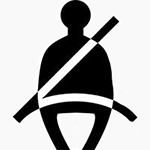Seat Belt Tickets
Fail to Wear Seat Belt – Highway Traffic Act 106
While driving a motor vehicle on a roadway in Ontario, all drivers must:
- wear the complete seat belt
- infants must be in child seats
- ensure passengers under 16 years wear a seat belts
- ensure small children are restrained within the vehicle
Passengers over the age of 16 years
The Highway Traffic Act of Ontario (HTA) requires that every person who is at least 16 years of age, and is a passenger in a motor vehicle on a road shall:
- occupy a seat for which a seat belt has been provided, and
- wear the complete seat belt assembly
Wearing Seat Belts
The seat belt must be worn so that:
- the pelvic restraint is worn firmly against the body and across the hips
- the torso restraint, if there is one, is worn closely against the body and over the shoulder and across the chest
- the pelvic restraint, and the torso restraint, if there is one, are securely fastened, and
- no more than one person is wearing the seat belt assembly at one time
Seat Belt Exemptions
The above rules do not apply to a person:
- who is driving the vehicle in reverse
- has a valid medical certificate signed by a doctor, that
- for the period stated in the certificate
- is unable for medical reasons
- to wear a seat belt assembly
- due to their size, build or otherwise
- a driver who is actually engaged in work that requires them
- to alight from or re-enter the vehicle
- at frequent intervals, and
- the vehicle does not exceed 40km/h
Definition
“seat belt assembly” means a device or assembly composed of straps, webbing or similar material that restrains the movement of a person in order to prevent or mitigate injury to the person and includes a pelvic restraint or pelvic restraint and a torso restraint.
Seat Belt Assembly not be Removed or Altered
No person shall drive on a highway a motor vehicle in which a seat belt assembly required under the Motor Vehicle Safety Act (Canada) at the time that the vehicle was manufactured or imported into Canada has been:
- removed,
- rendered partly or wholly inoperative,
- modified so as to reduce its effectiveness or
- is not operating properly through lack of maintenance.
Insurance Implications
A conviction on the drivers abstract for failing to wear a seat belt or failing to ensure passengers wear the seat belt can affect insurance rates.
Where an accident has occurred the insurance implications will be compounded because:
- a claim for the accident has been made
- a conviction has been registered on the driving record
The way the insurance company will finds out about the ticket is:
- The insurance company contacts
- the Ministry of Transportation and
- checks the drivers abstract, or
- the driver calls and
- tells the insurance company that they received a ticket
Each insurance company is a private company with their own set of rules and standards.
Some insurance companies will not increase insurance rates for one ticket and others will. The problem is drivers don’t know what the insurance company is going to do, and if asked, there is a chance they will increase it due to the inquiry.
Driving Records/Abstracts
A conviction on the drivers abstract for failing to wear a seat belt or failing to ensure passengers wear the seat belt can affect insurance rates.
Where an accident has occurred the insurance implications will be compounded because:
- a claim for the accident has been made
- a conviction has been registered on the driving record
Seat Belt Penalties
A seat belt tickets have the following penalties:
- 2 demerit points
- out of court fine of $240.00
- maximum fine of $500.00
- conviction appears on driving abstract for 3 years
- can affect insurance rates
Summons to Appear in Court
Where a police officer issues a summons to appear or the driver disputes the ticket, the Justice of the Peace (JP) can increase the fine up to $500.00. This rarely happens for seat belt tickets, it is possible.
The out of court fine is actually, $200.00 but the court adds a $40.00 Victim Fine Surcharge to the ticket.
What is the Victim Fine Surcharge?
- The provincial government adds a victim fine surcharge (VFS) to every non-parking fine imposed under the Provincial Offences Act.
- It is deposited into a special fund to help victims of crime.
- The amount of the VFS is usually 20 per cent of the imposed fine.
- For example, a $100 fine would result in a $20 surcharge.
- Fines over $1,000 carry a surcharge of 25 per cent.
Licence Suspensions
There is no licence suspension for not wearing seat belts.
Unpaid Fine Suspensions
Demerit Point Suspensions
The accumulation of demerit points can result in a licence suspension.
- Class G1 and G2 drivers are suspended for any one ticket with 4 demerit points
- Class G1 and G2 drivers are suspended for accumulating 6 demerit points
- Class G licences receive a drivers licence interview at 8 points
- Class G licences are suspended at 15 demerits
Legal Definition
Case Law
R. v. Maier, 1989 CanLII 3038 (AB QB)
1989-01-18 | 22 pages
seat belt — seat belts — principles of fundamental justice — security of the person — legislation
[…] [32] Similarly, as far as seat belt use is concerned, the rate of injury caused by seat belts is low, but the risk is clearly established. […] While the fatalities and injuries were reduced in Ontario after the introduction of seat belt legislation, no benefits were experienced in Quebec after the introduction of their seat belt legislation. […] In view of the above noted deficiencies in the evidence with respect to the efficacy of seat belts, the Crown has not discharged its onus of proving that compulsory seat belt wearing is rationally connected to the objective of the legislation, that is to say, protection of persons on the highway. […]
R. v. Merchant, 1990 CanLII 7372 (SK QB)
1990-09-14 | 3 pages | cited by 1 document
torso restraint — properly adjusted — securely fastened — wearing a seat belt — shoulder
[…] “Every person who drives a vehicle in which a seat belt assembly is provided for the driver on a highway shall wear the complete seat belt assembly in a properly adjusted and securely fastened manner.” […] seat belt assembly consisted of a pelvic restraint that was joined to a torso restraint, using the words in section 77(5) of the Act. Further, the evidence is clear that the appellant was, in the words of section 77(1), driving a vehicle in which a seat belt assembly was provided, and that he was driving on a highway. […] Counsel for the Crown has quite fairly acknowledged that the appellant was wearing a seat belt and that the appellant’s torso was restrained by the torso restraint portion of the seat belt. […]
York (Regional Municipality) v. Tassone, 2007 ONCA 215
2007-03-27 | 2 pages | cited by 11 documents
seat belt — vehicle — drives on a highway — provincial offences — red
[…] [1] This appeal involves the interpretation of the Highway Traffic Act, R.S.O. 1990 c.H.8 , s. 106(3) , (since amended) which, at the relevant time, provided that “every person who drives on a highway a motor vehicle in which a seat belt assembly is provided for the driver shall wear the complete seat belt assembly in a […] The officer illuminated the vehicle and confirmed that the driver was not wearing his seat belt. […] The driver then pulled the seat belt across his body. [3] The respondent was charged with failing to wear a seat belt contrary to s. 106(3). […]


